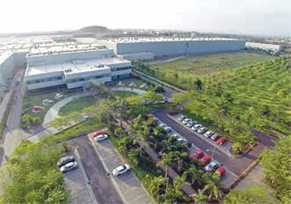Corporate Citizen claps for the engineering marvel and bringing India’s latest tourist destination on the world map - the ‘Statue of Unity’, located on the Narmada river island facing Gujarat’s Sardar Sarovar Dam in Kevadiya colony, some 100 kilometers southeast of Vadodara

Designated as the world’s tallest statue with a height of 182 meters (597 ft), the monument most fittingly pays tribute to the ‘Ironman of India’ – Sardar Vallabhbhai Patel, one of India’s most prominent leaders at the forefront of the freedom movement. Following its unveiling that also commemorated his 143rd birth anniversary, it has attracted footfalls of more than 1.28 lakh visitors in the first 11 days. Larsen & Toubro bagged the engineering contract in October 2014 at a costing of Rs.2,989 crore (US$420 million); involving the design, construction and maintenance of the iconic structure. India’s first Deputy Prime Minister, Sardar Patel is much respected for unifying hundreds of India’s erstwhile princely states to form India’s modern political boundary. Designed by eminent sculptor Ram V. Sutar in consultation with a team of historians, artists, and academics who chose a naturalistic portrayal of Sardar Patel in his characteristic garb and in a walking pose. “The expression, posture and pose justify the dignity, confidence, iron will as well as kindness that his persona exudes”, said Anil Sutar, Ram Sutar’s son. The iron collected from farmers across India for the structure adds to the spirit of unity. “The statue structure was to be designed for 180 km per hour wind speed. And if you have seen all the huge statues in the world they have a wide base on which they stand. In case of this statue, the standing leader’s two legs were to be shown separate, which resulted in a narrow base for the structure. This was the biggest challenge, as one has to make the structure withstand the high wind speed at the same time, it should meet the sculptors’ aesthetic requirements, ”said L&T. The monument is likely to generate employment in the tribal area of Narmada district as well as boost its tourism sector. Here’s hoping it does so and relives Patel’s dream of a unified nation and in his words, “A nation is as strong as it is united as weak as it is divided.
Corporate Citizen slaps the motives that draw extortionist to dampen industrial growth and curtail ‘ease of doing business’ by firms

Mafia infringement in industrial zones is not a new occurrence but attempts are often made to assert local claim to a slice of the industrial progression - not through the ‘right to skill’ but ‘the might to steal’! Pune’s Chakan area with 604 industrial units prides itself as one of the top notch industrial and automobile manufacturing belts in Maharashtra and is battling the mafia menace. The belt is dotted by manufacturing units of Volkswagen, Tetra Pak, Bridgestone, Mercedes-Benz, GM, Schindler, Foton, Tata Motors along with several Japanese, Korean, French, Dutch, Chinese, British and Indian companies which has now got Maharashtra Chief minister Devendra Fadnavis’ office to take note of the complaints; especially those that were recently forwarded by German Consul General Jüergen Morhard, regarding harassment of German firms across the Chakan belt. Morhard, has publicly sought police help in warding off the mafia nuisance on issues related to tenders, water tanker supply and its control by the tanker mafia; labor issues and the demand for local Mathadi tribe to be employed on priority. While the companies are unable to hire manpower freely and control costs of certain inputs due to the mafia stronghold, there have been no official complaint lodged as such. The police need a FIR for any action to be taken, explained R K Padmanabhan, Pimpri Chinchwad police commissioner. He assured that in some cases, the police can likely take suo motu action and FIRs could be initiated on charges of extortion, violence, violent threats, obstruction and other sections of the IPC. Senior government officials also noted that the mafia influences smaller contracts such as disposal of industrial scrap and discarded metals, which is a big money spinner. Historically, in the early 2000s, when the area started developing, the locals sold their land for industrial purposes but, now want jobs from these very companies, but are ill-qualified for the jobs available. Invariably an egg and chicken situation but, someone needs to bell the Big M!
by Sangeeta Ghosh Dastidar